A new campus makerspace opened last week in the J. Erskine Love Jr. Manufacturing building: the Materials Innovation & Learning Lab (MILL), a two-room makerspace with a materials science focus.
The lab contains five new multi-material 3D printers along with advanced analytical equipment such as a scanning electron microscope and a tensile tester for material characterization.
For Ben Ibach, fourth-year MSE and student overseer of the executive council that created the MILL over the past year, the MILL’s opening is the result of a lot of hard work and long hours. The MILL is designed to give Materials Science and Engineering (MSE) students an opportunity to apply concepts learned in class.
“MSE students felt like there was something missing from their degree,” Ibach said, “where students didn’t really feel like they were really utilizing the things they learn in their lectures outside of class, in the lab setting, until they got to an internship. … That’s kind of where the idea was initially born.”
After a survey of the MSE department identified what equipment students wanted most in a potential materials-themed makerspace, a group of students, including Ibach, worked with the MSE department alongside an external advisory board consisting of industry sponsors to develop the space that became the MILL.
“We were given two abandoned research labs from old professors that have left Georgia Tech to move on to other schools and other opportunities — and what we’re doing is basically converting these spaces into our own little makerspace,” Ibach said.
Besides Mechanical Engineering’s well-known Invention Studio, other Tech departments have begun to create their own makerspaces.
Recently, the School of Aerospace Engineering created an Aero Maker Space while the School of Electrical and Computer Engineering has plans to begin construction of a three-story ECE-themed makerspace to replace the rotunda attached to Van Leer.
Ibach said that a concentration on special materials and material analysis sets the MILL’s capabilities apart from that of the Invention Studio and other nascent makerspaces on campus.
“Our focus is more on the actual materials that you are using, because there’s a big difference in the type of material that you’re using, whether that’s ceramic, metal, plastic or even within that, how you are printing it,” Ibach said. “What you can do with these 3D printers is that you can vary things like whether it’s a solid or it has a honeycomb structure on the inside. The MSE department has this big focus on how little tiny changes to a material can affect overall properties of what you’re creating.”
Three of the five multi-material 3D printers even have temperature control, to allow for greater precision over material structure for “when you’re trying to get down to the really detailed level,” Ibach said.
Ibach mentioned that the MILL hopes to expand the stock of materials that students can use with their 3D printers.
“We have all of these different types of materials that we’re really excited to start playing around with,” Ibach said. “I think right now in our first kind of batch [of materials] we have there are probably 20, but you can get up to 50, 60, even more different types of materials that we’re hoping to print with.”
Currently, the MILL is open in a limited preliminary phase in order to determine the capabilities of its equipment, and for the remainder of the fall semester, students will only be able to access the lab by appointment, with preference given to MSE students over others.
“For right now, what we’re doing is having this appointment basis where if you’re interested in [a piece of equipment] or you’re interested in learning about [the MILL], you can contact that person,” Ibach said. “We have one or two people in charge of each of these pieces of equipment that know how they work, that understand how they work or currently are trying to figure that out.”
The plan is to develop a firm model of the day-to-day operations of the MILL during the fall and then open the maker space for all Tech students in Spring 2017.
“We’re also hoping to use [the MILL] in terms of outreach for prospective students, whether that’s MSE students or recruiting high school students for the department,” Ibach said.
“But also you can envision even for K-12 outreach, maybe having a demo day for local middle students to come in, and we teach them how to use a 3D printer and how these different parameters we work with, that we learn about here, affect how the world around us really works.”
The effects of materials are all around — one just has to look.
“That’s the nice thing about material science: you can look around, and there’s a material; there’s a material. … You can start to teach kids how to think that way too.”
The School of Materials Science and Engineering was technically founded in 1897 by the Georgia Legislature to support the rapid growth of the textile industry in Georgia at the time. Over time, the name of the school changed to reflect a shift from solely textiles to ceramics and mineral engineering.
The School of Materials Engineering was renamed the School of Materials Science and Engineering in 1992, and in 2010 the School of Materials Science and Engineering merged with the School of Polymer, Textile and Fiber Engineering.
